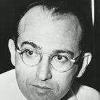

Magazine cover photo of Jonas Salk taken by Yousuf Karsh specifically for Topics: Entertainment Tags: Jonas Salk View |
Tags: Jonas Salk View |
Tags: Jonas Salk View |
|||||||||
Jonas Edward Salk (October 28, 1914 – June 23, 1995) was an American medical researcher and virologist, best known for his discovery and development of the first safe and effective polio vaccine. He was born in New York City to parents from Russian-Jewish immigrant families. Although they themselves did not have much formal education, they were determined to see their children succeed. While attending medical school at New York University, he stood out from his peers not just because of his academic prowess, but because he chose to do medical research instead of becoming a physician.
Until 1955, when the Salk vaccine was introduced, polio was considered the most frightening public health problems of the postwar United States. Annual epidemics were increasingly devastating. The 1952 epidemic was the worst outbreak in the nations history. Of nearly 58,000 cases reported that year, 3,145 died and 21,269 were left with mild to disabling paralysis, with most of the victims being children. The "public reaction was to a plague", said historian William ONeill. "Citizens of urban areas were to be terrified every summer when this frightful visitor returned." According to a 2009 PBS documentary, "Apart from the atomic bomb, Americas greatest fear was polio. As a result, scientists were in a frantic race to find a way to prevent or cure the disease. US President Franklin D. Roosevelt was the worlds most recognized victim of the disease and founded the organization that would fund the development of a vaccine.
In 1947, Salk accepted an appointment to the University of Pittsburgh School of Medicine. In 1948, he undertook a project funded by the National Foundation for Infantile Paralysis to determine the number of different types of polio virus. Salk saw an opportunity to extend this project towards developing a vaccine against polio, and, together with the skilled research team he assembled, devoted himself to this work for the next seven years. The field trial set up to test the Salk vaccine was, according to ONeill, "the most elaborate program of its kind in history, involving 20,000 physicians and public health officers, 64,000 school personnel, and 220,000 volunteers." Over 1,800,000 school children took part in the trial. When news of the vaccines success was made public on April 12, 1955, Salk was hailed as a "miracle worker", and the day "almost became a national holiday." His sole focus had been to develop a safe and effective vaccine as rapidly as possible, with no interest in personal profit. When he was asked in a televised interview who owned the patent to the vaccine, Salk replied: "There is no patent. Could you patent the sun?"
In 1960, he founded the Salk Institute for Biological Studies in La Jolla, which is today a center for medical and scientific research. He continued to conduct research and publish books, including Man Unfolding (1972), The Survival of the Wisest (1973), World Population and Human Values: A New Reality (1981), and Anatomy of Reality: Merging of Intuition and Reason (1983). Dr. Salks last years were spent searching for a vaccine against HIV.
Date of birth: 1914-10-28
Birth Location: New York City,, United States
Date of death: 1995-06-23
Death Location: La Jolla, California,, United States
Residence: USA
Nationality: American
Ethnicity: Russian-Jewish
Field: Medical research,,virology and epidemiology
Work Institution: University of Pittsburgh
Alma Mater: City College of New YorkNew York University
Doctoral Advisor: Thomas Francis, Jr.
Known For: First polio vaccine (polio vaccine)
Prizes: Lasker Award (1956)



